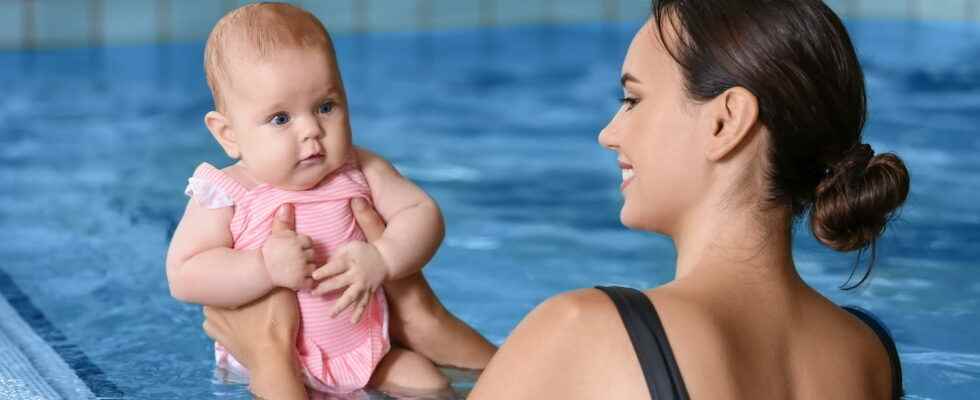From when can you take your baby to a swimming pool? What precautions should be taken to ensure that this first experience goes as smoothly as possible? Age, vaccines, water temperature… Swimming teacher Jeremie from Jeremcoach answers our questions.
Your baby is starting to grow and as the months pass, you can’t wait, take her to the swimming pool, to let him splash around in your arms. But at what age is it recommended to bathe baby and what should be provided? The lifeguard jeremcoach answers our questions about baby vaccines, the temperature of the swimming pool or the duration of swimming.
At what age should a baby be taken to the pool for the first time?
In general, you can take your baby to the swimming pool from 6 months, “we can start a little earlier, if the vaccines of the 5 months have all been done“, says the lifeguard. Indeed, we must therefore wait until our toddler is up to date with his vaccines to be able to start splashing him.
What temperature should the pool water be at?
The water temperature should be heated to 32 degrees. “Normally, this is the temperature imposed in municipal swimming pools to be able to accommodate babies”, says the lifeguard. This is another reason why “it is better not to bathe your baby in a basin before six months, because the temperature of the water will be too cold for him”he adds.
Recommended swimming time for a baby?
Sessions generally last a maximum of 30 minutes. “It’s enough, because after the babies are very tired”, observes the swimming instructor. However, if our child does not move much and has lips that change color, we leave the pooleven if it’s only been 10 minutes, because this is a sign that he is cold. “Hence the importance that the water is sufficiently heated so that he does not get cold too quickly. He will thus be able to enjoy and not tense up”, he recalls. We therefore adapt the time to the dynamics of the child and the temperature of the water.
When can baby put his head under water?
From 6 months, the child can put his head under water. “Some children are a little more apprehensive and we wait a bit, it’s not very serious. Above all, we don’t force”, suggests Jeremcoach. In all cases, “We avoid having him put his head under water from his first session in the pool, so that he has time to adapt to this new environment”. Unless of course he launches himself or tilts his head to go!
What age for a baby swimming session?
As soon as the child is old enough to enter a pool, he can participate in baby swimming sessions, that is to say from 6 months. And, we can register it in baby swimmers up to about 3 years old. “The earlier we start, the sooner we work on motor skills with the baby and the water is a good support”, assures Jeremcoach. Indeed, these sessions will allow him to develop a little faster in the water and to indulge in new things according to his evolution. “These sessions will not teach him to swim, but to feel comfortable in the water.an element that he will know later when he learns to swim”, he notes. It is also a moment of rest and relaxation for the child. And one time to bond parent/child. Note that a baby swimming session takes place with one or both parents, it depends on the rules of the establishments.
What accessories should be provided for babies at the swimming pool?
- A baby diaper waterproof or eco-washable specially designed to go in the water.
- A swimsuit (even if it is often possible to simply leave the child in his diaper).
- Cap is not always mandatory for babies. It all depends on the internal regulations of each swimming pool. But, “often for babies, it is not imposed, because stuck to their head, it can disturb them, when they do not yet have much hair”reports the lifeguard.
- A pair of armbands from 2 years old approximately (the age may vary a little depending on the weight of the child). “We avoid the buoy to put on, because if it turns around, the baby finds his head upside down and his feet stuck in it”, laments the swimming instructor. Moreover, “he just has his feet soaking in the water, so stuck, he can’t fully work his motor skills”, he points out. The best thing then, as long as he can’t wear armbands: hold him in our arms.
- A good towel to wrap him when he comes out of the pool.
- A snack. The swimming pool is hollow, so we provide him with a small snack such as a water bottle compote (practical to carry) or a bibi.
